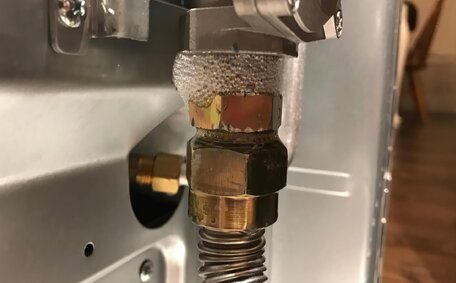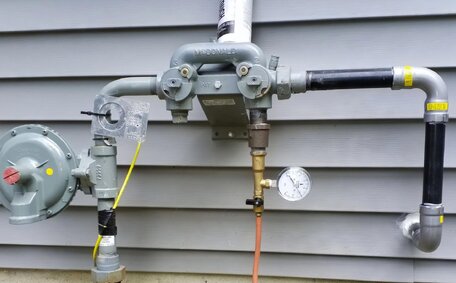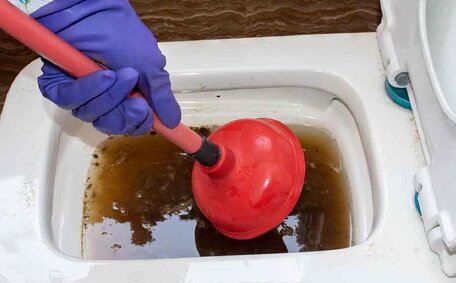What constitutes a plumbing emergency?
A plumbing emergency requires immediate action to prevent further harm or the loss of key services and usually arises without warning. Examples include burst pipes, sewer blockages, gas leaks, and major leaks causing flooding and potential loss of water or hot water services.
Slow leaks, dripping faucets, or faulty boilers are not typically classified as emergencies in home insurance policies.
Insurers define a plumbing emergency by criteria such as:
- Risks to personal safety and property accessibility
- The likelihood of secondary damage if ignored
- The immediate and unforeseen nature of the issue
- The complete loss of essential services
Contacting a professional team like Kenthurst Plumbing promptly can hasten the insurance process and efficiently resolve your drainage problems. Our experts can assess the damage severity to determine if emergency repairs fall under your policy’s coverage.
Types of common plumbing emergencies covered
Emergency plumbing insurance typically covers sudden incidents such as:
- Burst pipes that lead to water damage
- Backed up plumbing drainage systems and sewage overflow
- Gas leaks
- Complete loss, potentially causing damage, to your water supply
- Total failure of hot water systems
- Broken water pipes causing water damage
- Blocked stormwater drains adjacent to windows doors during heavy rain
Most homeowner’s insurance policies cover unexpected plumbing emergencies posing immediate threats, not gradual wear and tear damage. Regular maintenance can prevent covered problems from escalating into emergencies. Consult with our specialists at Kenthurst Plumbing to fully understand your plan’s home emergency coverage.
Sewage backups
Sewage backups causing flooding are typical emergencies covered by insurance. Backups may be due to blockages, pipe breaks, power outages affecting your pumping system, or heavy rain infiltrating pipes.
If raw sewage has overflowed inside, take urgent steps like:
- Turn off electricity to affected areas to safeguard personal safety property and prevent electrocution
- Block drains and contain contamination
- Turn off main water valve so emergency rescue teams can safely enter the area
- Ventilate property to limit health risks
- Call Kenthurst Plumbing for our emergency plumbing services to handle clean-up and repairs
Your homeowner’s insurance company policies typically cover cost for sewage extraction, sanitization, tear-out of water-damaged areas, equipment repairs or replacement, and testing for pathogens. Make sure to For your claim, document all damage meticulously. Acting quickly helps minimise further issues.
Situations not covered by emergency plumbing insurance
There are some home plumbing issues that standard emergency plumbing insurance policies, like those without home assist optional cover, typically don’t cover. Exclusions, which make up a full list of areas optional cover may address, include:
- Gradual damage, such as corrosion-induced leaks evolving into a burst, isn’t typically covered under wear and tear.
- Pre-existing problems the homeowner was aware of prior to taking the policy.
- Lack of general maintenance which led to an emergency - Insurance is meant to cover unforeseen events, not issues that could reasonably have been prevented by routine maintenance.
- Incidents caused by negligent use of plumbing systems or failure to make timely repairs.
- Upgrading outdated or inadequate plumbing systems.
- Landscape water systems and sprinkler damage.
- Swimming pool or spa equipment repairs.
Understanding precisely what your insurance covers for plumbing emergencies is vital during policy review. Consult with Kenthurst Plumbing for clarity on any unclear aspects, ensuring you get the accurate information required. We can also provide maintenance tips to help avoid emergency callouts.
Gradual damage and leaks
Under most home insurance policies, gradual damage and leaks over time are typically excluded from emergency plumbing insurance coverage.
This spans problems such as corrosion, scaling, cracking, or slow water leaks that result in gradual damage or wear and tear leading to failure. As some policies aim to cover more than sudden and unforeseen loss events where immediate action is required, gradual deterioration is often seen as preventable through ongoing maintenance.
Insurers may reject claims if damage stems from extended neglect instead of a sudden emergency, as outlined in the terms and conditions.
Pipes that have rusted over years before finally leaking would fall under regular home insurance rather than emergency coverage. Insurers recommend homeowners check your systems periodically and fix minor problems early to avoid catastrophic emergencies requiring major repairs down the track.
At Kenthurst Plumbing, we know the ins and outs of delivering maintenance services that comply with home assist terms, helping homeowners to avert escalating issues such as pipe corrosion and leaks. We are happy to assess your systems and advise on any remedial work that may mitigate the risk of gradual damage turning into an emergency.
Updating old plumbing and fixing small leaks immediately is effective prevention.
Lack of maintenance
Lack of general maintenance on plumbing systems is a common reason for insurance claim denials when emergencies occur. Insurers may refuse to cover damage they deem foreseeable and preventable through routine upkeep.
As maintenance-related issues are frequently excluded, it can be challenging to get them covered; yet, active maintenance, potentially included in home assist, can increase the chance of claim approval.
Homeowners should have annual system inspections and promptly address issues to protect their homes from escalating problems. Regular checks allow for early detection of corrosion, leaks, clogs, or pressure discrepancies. Carrying out repairs, upgrades or part replacements as problems arise is wise prevention rather than allowing deterioration until an emergency happens.
Here are tips to prevent maintenance shortfalls from impeding your insurance claims:
- Have a licenced plumber conduct an annual maintenance check, following all recommendations
- Replace visibly worn components such as frayed pipe connectors or leaking taps
- Install drainage mesh screens on your roof, clean traps and use enzyme drain treatments to prevent clogs in your house
- Upgrade any outdated plumbing systems prone to failure
- Repair even minor leaks early before they worsen
- Maintain water pressure within safe ranges
- Clear debris from drainage systems around your property
Contact us today; our emergency plumber provides an on-site inspection that takes into account your legal liability for your business or residential property.
Providing evidence of preventive measures in case of an emergency can effectively support your claim and may lead to better outcomes. Our team at Kenthurst Plumbing can offer maintenance and upgrades that bring peace mind, preventing loss damage caused by emergencies from affecting your domicile.
Claim limits and waiting periods
Emergency plumbing insurance policies typically have defined limits on the amount they will cover for each claim. This usually ranges from $500 to $15,000, with higher limits available on comprehensive policies.
Frequently, there’s a waiting period, often about 60 days from the policy’s start date, before you can file a claim. Pre-existing plumbing problems known before taking out insurance will usually be permanently excluded.
Factors affecting your claim limit can include:
- The age and condition of your plumbing systems.
- Whether policy cover includes damage caused by gradual deterioration or only sudden unforeseen events.
- If fair wear and tear or lack of maintenance contributed.
- The total value home assist can bolster under your policy.
Even before the waiting period concludes, emergency repairs deemed necessary to prevent extensive secondary damage, such as flooding from a burst pipe, may validate a claim. Just be aware claimable costs may be capped.
To fully understand your policy’s coverage, including claim limits and waiting periods, review your Product Disclosure Statement (PDS) for cost coverage details. Our team at Kenthurst Plumbing can also explain typical policy fine print when it comes to making emergency claims.
Filing a claim for a plumbing emergency
If an emergency plumbing issue causes damage or loss of essential services at your Kenthurst property, follow these key steps when filing an insurance claim:
- Document the damage - Capture photos and video evidencing the extent of the issue and areas affected for your claim. Get written quotes from our team at Kenthurst Plumbing detailing necessary repairs, ensuring you understand your disclosure statement.
- Mitigate further damage - Take reasonable steps to ensure safety and reduce further losses or disruption to property function., such as turning off the main water valves in cases of significant leaks while awaiting repairs.
- Promptly contact Kenthurst Plumbing’s team - Contact your insurance provider’s hotline, operational 24 hours day 7 days, within the first day to lodge an emergency claim. Provide documentation gathered detailing the damage and repair requirements.
- Arrange emergency repairs - After approval, Kenthurst Plumbing can quickly send professionals, such as plumbers, electricians, and locksmiths, to perform policy-covered repairs, including pipe repairs, sewage clean-ups, hot water system fixes or responses to gas leaks.
- Submit claim documentation - Compile all quotes, invoices, repair reports and photographic evidence required by your insurer to settle your claim.
Following these steps in plumbing emergencies can simplify the claims process and promote seamless claim approvals. By engaging reputable specialists like Kenthurst Plumbing for home assist services, you strengthen justification for emergency repairs covered under your policy.
Preventing plumbing emergencies
There are several key steps homeowners can take to help prevent plumbing emergencies and reduce the chances of damage occurring:
- Have a licenced plumber conduct thorough inspections and maintenance checks on all plumbing annually. Carrying out repairs or upgrades recommended after these routine check-ups is wise prevention to help protect your property and avoid situations that could damage your home.
- Install protective devices like temperature and pressure relief valves on water heaters to release excess energy safely.
- Insulate all exposed or exterior pipes vulnerable to freezing in winter.
- Upgrade old steel pipes prone to bursting to newer copper as a preventive measure.
- Set up devices such as leak detection systems that cut off water or any other measures when they detect moisture.
- Repair minor leaks early before they can cause further deterioration.
- Clear debris from gutters and drainage areas which could lead to overflow.
- Don’t plant trees or shrubs near drainage systems whose roots could infiltrate and clog pipes.
Following expert advice on preventive measures diminishes the chance of minor issues turning into major plumbing disasters. Documented preventive maintenance can bolster emergency insurance claims should unforeseen damage occur. Contact our team at Kenthurst Plumbing today to understand how we can help you proactively avoid plumbing emergencies.






